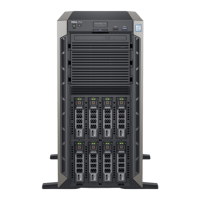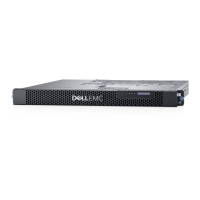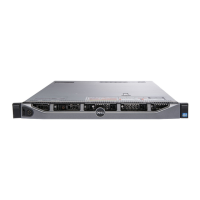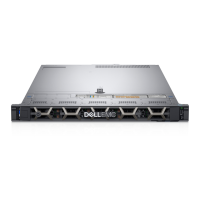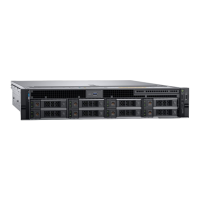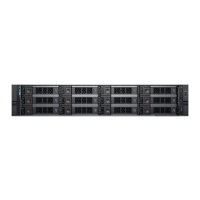Do you have a question about the Dell EMC PowerEdge T40 and is the answer not in the manual?
Illustrates and describes the components visible on the front panel of the system.
Illustrates and describes the ports and connectors on the rear panel of the system.
Provides a visual overview of the internal components and their layout within the system.
Explains how to find the system's unique identification information, such as Service Tag.
Details the electrical and mechanical layout of the system board and its components.
Provides step-by-step instructions for unpacking, connecting, and powering on the system.
Lists resources and methods for installing a supported operating system on the system.
Explains how to download and install the latest BIOS, drivers, and system management firmware.
Outlines the available options for managing the system before the operating system loads.
Details how to configure BIOS settings and device settings for system management.
Provides instructions on how to access and navigate the System Setup utility.
Explains how to use the one-time boot menu for selecting boot devices and running diagnostics.
Lists the keyboard keys used for navigating within the System Setup utility.
Describes various configuration options available within the System Setup utility.
Details settings for integrated NIC, serial port, SATA operation, and drive configurations.
Explains how to set the system's date and time within the BIOS.
Allows enabling or disabling memory mapping above 4 GB.
Enables or disables the audio feature and internal speaker.
Covers enabling or disabling various on-board devices, including PCI slots.
Details settings for multi-display features and primary display controller selection.
Covers password settings, configuration, bypass options, and TPM security.
Manages Trusted Platform Module (TPM) settings like visibility, bypass, and attestation.
Controls the chassis intrusion detection feature.
Enables or disables the OROM keyboard access.
Prevents users from entering Setup when an Admin password is set.
Prevents users from entering Setup when a Master password is set.
Enables or disables additional UEFI SMM security mitigation protections.
Manages Secure Boot settings, including deployment mode and key management.
Configures processor performance features like multi-core support, SpeedStep, C-States, and TurboBoost.
Sets system response to AC power restoration and controls Intel Speed Shift Technology.
Configures NumLock LED, keyboard error reporting, BIOS POST delay, and warning/error handling.
Covers Intel AMT capability, USB provisioning, and MEBx hotkey settings.
Enables or disables VT for Direct I/O and Trusted Execution for virtualization.
Covers service tag, asset tag, SERR messages, BIOS downgrade, data wipe, and recovery options.
Allows viewing and clearing system event logs.
Configures ASPM power management levels and PCIe link speeds.
Provides instructions for updating the system BIOS via various methods.
Details precautions for updating BIOS when BitLocker is enabled to prevent data loss.
Guides on how to update the system BIOS using a bootable USB flash drive.
Explains how to flash the BIOS using the F12 one-time boot menu with a USB key.
Covers setting and managing system passwords for security.
Provides steps to assign or change a system and/or setup password.
Details how to delete or modify existing system and setup passwords.
Explains how to use the Preboot Execution Environment (PXE) for remote system configuration.
Outlines critical safety precautions to be followed before and during system servicing.
Lists prerequisites and steps to prepare the system before performing internal maintenance.
Lists steps to complete after internal maintenance and before powering on the system.
Lists the necessary tools required for performing hardware removal and installation procedures.
Details the procedures for removing and installing the system's outer cover.
Provides step-by-step instructions for safely removing the system cover.
Provides step-by-step instructions for correctly reinstalling the system cover.
Covers the procedures for removing and installing the front bezel of the system.
Details the steps required to detach and remove the front bezel.
Provides instructions on how to properly attach and secure the front bezel.
Guides on removing and installing drive carriers and the drives themselves.
Explains how to safely remove a drive carrier from its bay.
Provides instructions for inserting a drive carrier into the system's drive bay.
Details the steps for removing a hard drive from its carrier.
Provides instructions for installing a hard drive into its carrier.
Covers the procedures for opening and closing the power supply unit (PSU) assembly.
Details how to release and open the power supply unit assembly.
Provides instructions for securely closing the power supply unit assembly.
Guides on removing and installing the system's power supply unit.
Details the steps for safely disconnecting and removing the power supply unit.
Provides instructions for inserting and securing the power supply unit.
Covers the removal and installation of expansion cards.
Details the procedure for safely removing an expansion card from its slot.
Provides instructions for inserting and securing an expansion card into its slot.
Covers system memory guidelines and procedures for installing/removing memory modules.
Provides rules and recommendations for installing memory modules for optimal performance.
Details the steps for safely removing a memory module from its socket.
Provides instructions for inserting a memory module into its socket correctly.
Covers the procedure for replacing the system battery.
Details the steps for safely removing and installing the system's CMOS battery.
Covers the removal and installation of the optical drive.
Details the steps for safely disconnecting and removing the optical drive.
Provides instructions for inserting and securing the optical drive.
Covers the removal and installation of the system speaker.
Details the steps for safely disconnecting and removing the system speaker.
Provides instructions for inserting and connecting the system speaker.
Covers the removal and installation of system fans.
Details the steps for safely disconnecting and removing the system fan.
Provides instructions for inserting and securing the system fan.
Covers the removal and installation of the chassis intrusion switch.
Details the steps for safely disconnecting and removing the intrusion switch.
Provides instructions for inserting and connecting the intrusion switch.
Covers the removal and installation of the processor and its heatsink module.
Details the steps for safely disconnecting and removing the processor heatsink module.
Details the steps for safely removing the processor from its socket.
Provides instructions for correctly installing the processor into its socket.
Provides instructions for applying thermal grease and installing the heatsink module.
Covers the removal and installation of the system board.
Details the steps for safely disconnecting and removing the system board.
Provides instructions for correctly installing the system board.
Guides on entering the system service tag via the Service Menu after board replacement.
Explains how to enter the system service tag using the System Setup utility.
Covers the removal and installation of the system's control panel.
Details the steps for safely disconnecting and removing the control panel.
Provides instructions for inserting and securing the control panel.
Covers the removal and installation of the power button module.
Details the steps for safely disconnecting and removing the power button module.
Provides instructions for inserting and securing the power button module.
Illustrates and identifies the various jumpers and connectors on the system board.
Details the settings and functions of system board jumpers.
Explains how to use a jumper to clear system and setup passwords.
Provides the physical dimensions of the system chassis.
Lists the weight specifications for the system configuration.
Details the supported processors, their models, and associated graphics capabilities.
Lists the operating systems supported by the PowerEdge T40 system.
Provides details about the system's power supply unit, including wattage and specifications.
Describes the system's cooling fans, including their location and quantity.
Specifies the type and voltage of the system's battery.
Details the types and number of expansion cards supported by the system.
Outlines the supported DIMM types, capacities, and RAM configurations.
Describes the storage controller capabilities, including software RAID support.
Details the supported drive configurations and capacities.
Lists the types of optical drives supported by the system.
Details the specifications for all system ports and connectors.
Specifies the number and type of USB ports on the front and rear panels.
Details the specifications for the Network Interface Controller (NIC) port.
Describes the serial connector's specifications and compliance.
Specifies the number and location of DisplayPorts on the system.
Lists the video capabilities and supported graphics processors.
Provides information on environmental certifications and requirements.
Details the operating and storage temperature ranges for the system.
Specifies the acceptable ranges for relative humidity during operation and storage.
Outlines the maximum vibration levels the system can withstand.
Details the maximum shock pulse levels the system can tolerate.
Specifies the maximum operating and storage altitudes for the system.
Describes temperature derating at higher altitudes.
Provides a matrix of restrictions based on ambient temperature for components.
Details requirements for air filtration and protection against contamination.
Describes the meaning of the front panel status indicators and their conditions.
Details the link and activity indicators for the Network Interface Controller (NIC).
Guides on performing the built-in self-test for the power supply unit.
Provides steps to identify a potentially faulty power supply unit.
Introduces the ePSA diagnostics for hardware checks before the OS loads.
Provides instructions on how to initiate and run the ePSA diagnostic tests.
Explains how power status lights indicate system status during diagnostics.
Lists diagnostic LED flash patterns and beep codes for troubleshooting.
Provides descriptions for various diagnostic error messages encountered during system startup.
Lists and describes system error messages, including troubleshooting steps.
Offers information on responsible disposal and recycling services for system components.
Explains how to upload system reports and files to Dell Technical Support.
Provides information on how to contact Dell for sales and technical support.
Guides on using the Quick Resource Locator (QRL) for system information and support.
Provides links and descriptions for further system documentation and resources.
| Chipset | Intel C246 |
|---|---|
| Maximum Memory | 64 GB |
| Memory Slots | 4 DIMM slots |
| Network Controller | Intel I219-LM |
| Form Factor | Tower |
| Processor Options | Intel Pentium Gold G5420, Intel Core i3-9100 |
| Processor Cores | 4 |
| Processor Threads | 4 |
| Memory Type | DDR4 UDIMM |
| Memory | 8 GB |
| Maximum Internal Storage | 16 TB |
| Storage Controller | Intel AHCI 6Gb/s SATA |
| RAID Support | RAID 0, 1, 5, 10 (with PERC H330) |
| Drive Bays | 4 x 3.5" Cabled HDD |
| Expansion Slots | 1 x PCIe 3.0 x16, 1 x PCIe 3.0 x4, 1 x PCIe 3.0 x1 |
| Network | 1 x 1GbE |
| Dimensions (H x W x D) | 17.5 cm x 45.4 cm |
| Operating System Support | Windows Server 2019, Red Hat Enterprise Linux, SUSE Linux Enterprise Server |
| Power Supply | 300W |
